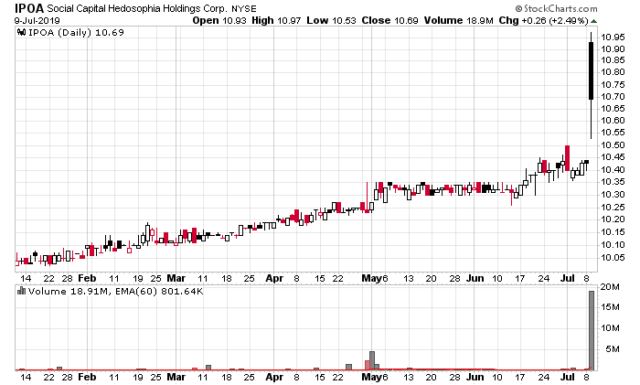Apparently Virgin Galactic is going public, via a SPAC currently traded as (NYSE: IPOA). The SPAC is a Cayman Islands shell capitalized with US$708 million cash waiting to be invested by its control owner, Chamath Palihapitiya. Before the Virgin Galactic announcement IPOA was pretty much trading at salvage value (it has a designated 2 year lifespan to invest in anything before it had to be liquidated):
When reading the news, my initial reaction was that IPOA would jump to the roof, as the market itself (space tourism) is relatively untapped from a publicly traded perspective. I wanted to flip the stock like pancakes on a griddle. IPOA was going to receive 49% of the Virgin Galactic entity.
The powerpoint deck associated with the announcement is located here. Skip to page 55 – financial overview for the meat of what an investor would be buying into.
Somebody investing in IPOA is taking a blind leap of faith. Why would Virgin sell a huge stake in the business if it was actually going to generate the numbers claimed? The presentation talks about being EBITDA profitable in 2021, but the underlying reality is that if you can’t even get a low cost domestic flight company (with two leased Airbus 320s) going without injecting a ton of capital and a lot of pain, what makes one think that running a one-of-a-kind rocket ship is going to be any different? The other question is – who in their might mind will pay US$250,000 for a ticket to a 55-mile above planet earth trip and do it again? There doesn’t appear to be a lot of ‘repeat’ value in these types of trips unless if they can make them similar to SpaceX’s vision of a 1 hour trip to anywhere on earth (which, if reliable and repeatable, I could see a true market for – it won’t happen because of noise pollution). But it also brings up the question of operational risk – one crash and the business is shot for at least half a decade.
Whenever I get the compulsion to buy something based off of a news headline in the Drudge Report, I solve this by performing imaginary day-trading. I inevitably lose money in my mind, and that relieves the psychological burden of not being involved. Of course, it is more agonizing when you look at entities like Beyond Burger and ask yourself what you’re doing reading balance sheets and income statements.
One of my negative screens is that if I read about some company on the mainstream news and it is not portrayed in an excessively negative light, I tend to exclude it as an investment candidate. The less attention given to a specific company means there is likely to be more value to be had by a closer examination. Markets are strange in this respect. But with Virgin Galactic, I’ll be a happy spectator and wish them the best of success – what they do is cool, similar to SpaceX.

